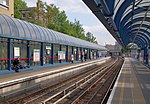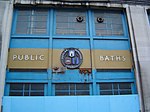All Saints Church, Poplar
1821 establishments in England19th-century Church of England church buildingsChurch of England church buildings in the London Borough of Tower HamletsChurches bombed by the Luftwaffe in LondonChurches completed in 1823 ... and 4 more
Diocese of LondonGrade II listed churches in LondonPoplar, LondonReligious organizations established in 1821

All Saints' Church, Poplar, is a church in Newby Place, Poplar, London Borough of Tower Hamlets, and is the Church of England parish church of Poplar. It was built in 1821–3 to serve the newly created parish. The church was designated a Grade II listed building on 19 July 1950.
Excerpt from the Wikipedia article All Saints Church, Poplar (License: CC BY-SA 3.0, Authors, Images).All Saints Church, Poplar
Newby Place, London Poplar
Geographical coordinates (GPS) Address Nearby Places Show on map
Geographical coordinates (GPS)
| Latitude | Longitude |
|---|---|
| N 51.509722222222 ° | E -0.012222222222222 ° |
Address
Newby Place
Newby Place
E14 0AX London, Poplar
England, United Kingdom
Open on Google Maps








